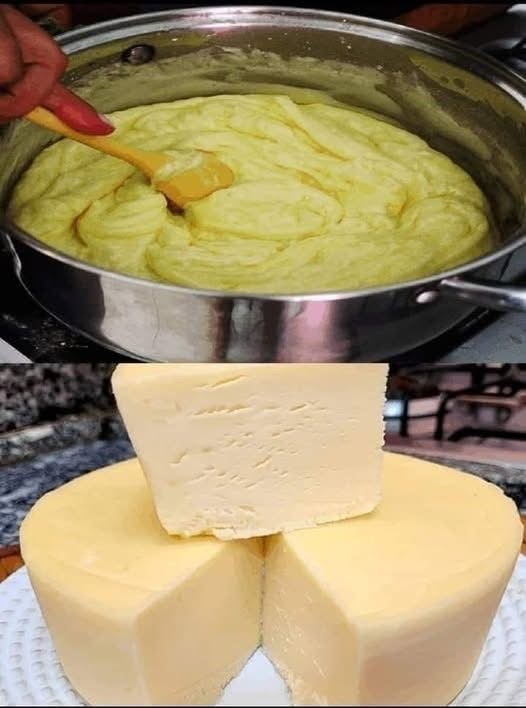Homemade Soft Cheese

Introduction
Making your own cheese at home is not only satisfying but also allows you to control the freshness, flavor, and texture. This recipe produces a creamy, semi-soft cheese with a mild flavor — perfect for sandwiches, snacks, or melting over hot dishes. It’s made using simple ingredients you probably already have: milk, butter, and yogurt or vinegar to curdle the milk.
Ingredients
- 2 liters full-fat cow’s milk (fresh, not UHT)
- 200 g unsalted butter
- 500 g plain yogurt (unsweetened) OR 4 tbsp white vinegar/lemon juice
- 1 tsp salt (adjust to taste)
Instructions
- Heat the milk
- Pour milk into a large stainless steel pot. Heat over medium flame until it reaches about 90°C (194°F) — just before boiling. Stir occasionally to prevent scorching.
- Add butter
- Add the butter to the hot milk. Stir until fully melted and combined.
- Curdle the milk
- Reduce heat to low. Add yogurt (or vinegar/lemon juice) slowly while stirring.
- Within a minute or two, you’ll see the curds separating from the whey (yellowish liquid).
- Cook the curds
- Continue gently stirring for about 5–7 minutes to allow full separation. Don’t mash the curds; keep them intact for a smooth texture.
- Strain the curds
- Line a colander with a clean cheesecloth. Pour the mixture through it to drain the whey.
- Sprinkle with salt and mix lightly.
- Shape the cheese
- Gather the cloth’s edges, twist to remove excess liquid, then press into a mold or bowl.
- Place a weight on top for 3–4 hours to firm up.
- Unmold & serve
- Once firm, remove from cloth. Your cheese is ready to slice and enjoy.
Methods
- Curdling method: Yogurt, vinegar, or lemon juice can be used — yogurt makes it creamier, while vinegar/lemon makes it slightly tangy.
- Pressing method: The longer you press, the firmer the cheese.
- Storage: Keep wrapped in parchment paper in the fridge; consume within 7–10 days.
History
This style of cheese has roots in rural kitchens worldwide — from Indian paneer to Middle Eastern labneh, to Latin American queso fresco. Farmers traditionally made it to preserve milk before refrigeration existed. The process is almost identical across cultures — heat milk, add an acid, separate curds, press, and enjoy.
Benefits
- Fresh & preservative-free — no additives.
- High protein — great for muscle repair and satiety.
- Calcium-rich — supports strong bones and teeth.
- Customizable flavor — can be made plain, herbed, or spiced.
Variations
- Add chopped herbs (basil, dill, parsley) before pressing.
- Mix in chili flakes or black pepper for a spicy kick.
- Blend with cream for an ultra-soft spreadable cheese.
Nutrition (per 30g slice)
- Calories: ~85 kcal
- Protein: 4 g
- Fat: 7 g
- Carbs: 1 g
- Calcium: ~100 mg
Conclusion
Homemade cheese is pure, creamy, and easy to make with just a few pantry ingredients. Once you master the technique, you can experiment with textures and flavors to suit your taste. Fresh cheese is more flavorful than store-bought and gives you a taste of traditional dairy craftsmanship at home.